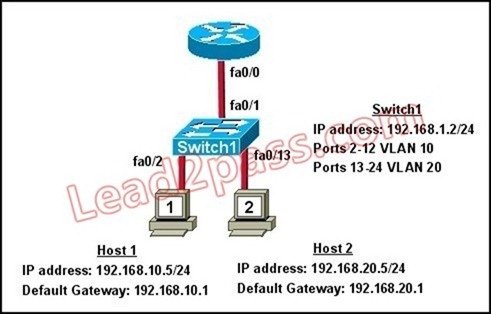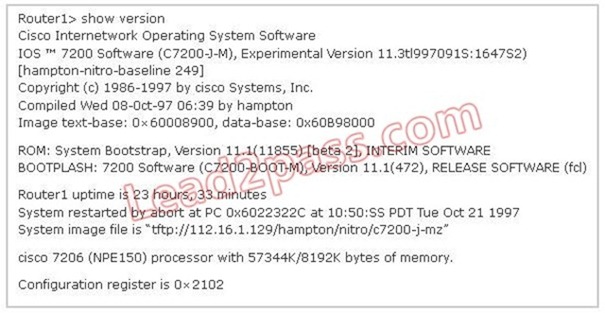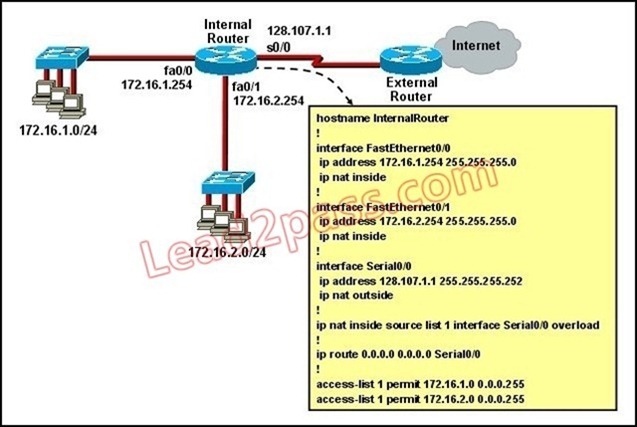2016 September Cisco Official New Released 200-125 Dumps in Lead2pass.com!
100% Free Download! 100% Pass Guaranteed!
How to 100% pass 200-125 exam? Lead2pass provides the guaranteed 200-125 exam dumps to boost up your confidence in 200-125 exam. Successful candidates have provided their reviews about our 200-125 dumps. Now Lead2pass supplying the new version of 200-125 VCE and PDF dumps. We ensure our 200-125 exam questions are the most complete and authoritative compared with others’, which will ensure your 200-125 exam pass.
Following questions and answers are all new published by Cisco Official Exam Center: http://www.lead2pass.com/200-125.html
QUESTION 121
Which two statements describe the process identifier that is used in the command to configure OSPF on a router? (Choose two.)
Router(config)# router ospf 1
A. All OSPF routers in an area must have the same process ID
B. Only one process number can be used on the same router.
C. Different process identifiers can be used to run multiple OSPF processes
D. The process number can be any number from 1 to 65,535.
E. Hello packets are sent to each neighbor to determine the processor identifier.
Answer: CD
Explanation:
Multiple OSPF processes can be configured on a router using multiple process ID’s.
The valid process ID’s are shown below:
Edge-B(config)#router ospf ?
<1-65535> Process ID
QUESTION 122
Refer to the exhibit. What commands must be configured on the 2950 switch and the router to allow communication between host 1 and host 2? (Choose two.) 
A. Router(config)# interface fastethernet 0/0
Router(config-if)# ip address 192.168.1.1 255.255.255.0
Router(config-if)# no shut down
B. Router(config)# interface fastethernet 0/0
Router(config-if)# no shut down
Router(config)# interface fastethernet 0/0.1
Router(config-subif)# encapsulation dot1q 10
Router(config-subif)# ip address 192.168.10.1 255.255.255.0
Router(config)# interface fastethernet 0/0.2
Router(config-subif)# encapsulation dot1q 20
Router(config-subif)# ip address 192.168.20.1 255.255.255.0
C. Router(config)# router eigrp 100
Router(config-router)# network 192.168.10.0
Router(config-router)# network 192.168.20.0
D. Switch1(config)# vlan database
Switch1(config-vlan)# vtp domain XYZ
Switch1(config-vlan)# vtp server
E. Switch1(config)# interface fastethernet 0/1
Switch1(config-if)# switchport mode trunk
F. Switch1(config)# interface vlan 1
Switch1(config-if)# ip default-gateway 192.168.1.1
Answer: BE
Explanation:
The router will need to use subinterfaces, where each subinterface is assigned a VLAN and IP address for each VLAN. On the switch, the connection to the router need to be configured as a trunk using the switchport mode trunk command and it will need a default gateway for VLAN 1.
QUESTION 123
Refer to the exhibit. For what two reasons has the router loaded its IOS image from the location that is shown? (Choose two.) 
A. Router1 has specific boot system commands that instruct it to load IOS from a TFTP server.
B. Router1 is acting as a TFTP server for other routers.
C. Router1 cannot locate a valid IOS image in flash memory.
D. Router1 defaulted to ROMMON mode and loaded the IOS image from a TFTP server.
E. Cisco routers will first attempt to load an image from TFTP for management purposes.
Answer: AC
Explanation:
The loading sequence of CISCO IOS is as follows:
Booting up the router and locating the Cisco IOS
1. POST (power on self test)
2. Bootstrap code executed
3. Check Configuration Register value (NVRAM) which can be modified using the config-register command
0 = ROM Monitor mode
1 = ROM IOS
2 – 15 = startup-config in NVRAM
4. Startup-config filE. Check for boot system commands (NVRAM) If boot system commands in startup-config
a. Run boot system commands in order they appear in startup-config to locate the IOS b. [If boot system commands fail, use default fallback sequence to locate the IOS (Flash, TFTP, ROM)?]
If no boot system commands in startup-config use the default fallback sequence in locating the IOS:
a. Flash (sequential)
b. TFTP server (netboot)
c. ROM (partial IOS) or keep retrying TFTP depending upon router model
5. If IOS is loaded, but there is no startup-config file, the router will use the default fallback sequence for locating the IOS and then it will enter setup mode or the setup dialogue.
QUESTION 124
Refer to the exhibit. What can be determined about the router from the console output? 
A. No configuration file was found in NVRAM.
B. No configuration file was found in flash.
C. No configuration file was found in the PCMCIA card.
D. Configuration file is normal and will load in 15 seconds.
Answer: A
Explanation:
When no startup configuration file is found in NVRAM, the System Configuration Dialog will appear to ask if we want to enter the initial configuration dialog or not.
QUESTION 125
Which three elements must be used when you configure a router interface for VLAN trunking? (Choose three.)
A. one physical interface for each subinterface
B. one IP network or subnetwork for each subinterface
C. a management domain for each subinterface
D. subinterface encapsulation identifiers that match VLAN tags
E. one subinterface per VLAN
F. subinterface numbering that matches VLAN tags
Answer: BDE
Explanation:
This scenario is commonly called a router on a stick. A short, well written article on this operation can be found here:
http://www.thebryantadvantage.com/RouterOnAStickCCNACertificationExamTutorial.htm
QUESTION 126
Which commands are required to properly configure a router to run OSPF and to add network 192.168.16.0/24 to OSPF area 0? (Choose two.)
A. Router(config)# router ospf 0
B. Router(config)# router ospf 1
C. Router(config)# router ospf area 0
D. Router(config-router)# network 192.168.16.0 0.0.0.255 0
E. Router(config-router)# network 192.168.16.0 0.0.0.255 area 0
F. Router(config-router)# network 192.168.16.0 255.255.255.0 area 0
Answer: BE
Explanation:
In the router ospf
command, the ranges from 1 to 65535 so o is an invalid number -> but To configure OSPF, we need a wildcard in the “network” statement, not a subnet mask. We also need to assgin an area to this process -> .
QUESTION 127
A router receives information about network 192.168.10.0/24 from multiple sources. What will the router consider the most reliable information about the path to that network?
A. a directly connected interface with an address of 192.168.10.254/24
B. a static route to network 192.168.10.0/24
C. a RIP update for network 192.168.10.0/24
D. an OSPF update for network 192.168.0.0/16
E. a default route with a next hop address of 192.168.10.1
F. a static route to network 192.168.10.0/24 with a local serial interface configured as the next hop
Answer: A
Explanation:
When there is more than one way to reach a destination, it will choose the best one based on a couple of things. First, it will choose the route that has the longest match; meaning the most specific route. So, in this case the /24 routes will be chosen over the /16 routes. Next, from all the /24 routes it will choose the one with the lowest administrative distance. Directly connected routes have an AD of 1 so this will be the route chosen.
QUESTION 128
What is the default maximum number of equal-cost paths that can be placed into the routing table of a Cisco OSPF router?
A. 2
B. 4
C. 16
D. unlimited
Answer: B
Explanation:
maximum-paths (OSPF)
To control the maximum number of parallel routes that Open Shortest Path First (OSPF) can support, use the maximum-paths command.
Syntax Description
maximum
Maximum number of parallel routes that OSPF can install in a routing table. The range is from 1 to 16 routes.
Command Default
8 paths
QUESTION 129
Which command shows your active Telnet connections?
A. show cdp neigbors
B. show session
C. show users
D. show vty logins
Answer: B
Explanation:
The “show users” shows telnet/ssh connections to your router while “show sessions” shows telnet/ssh connections from your router (to other devices). The question asks about “your active Telnet connections”, meaning connections from your router so the answer should be A.
QUESTION 130
Refer to the exhibit. What statement is true of the configuration for this network? 
A. The configuration that is shown provides inadequate outside address space for translation of the
number of inside addresses that are supported.
B. Because of the addressing on interface FastEthernet0/1, the Serial0/0 interface address will not
support the NAT configuration as shown.
C. The number 1 referred to in the ip nat inside source command references access-list number 1.
D. ExternalRouter must be configured with static routes to networks 172.16.1.0/24 and 172.16.2.0/24.
Answer: C
Explanation:
The “list 1 refers to the access-list number 1.
QUESTION 131
Which type of EIGRP route entry describes a feasible successor?
A. a backup route, stored in the routing table
B. a primary route, stored in the routing table
C. a backup route, stored in the topology table
D. a primary route, stored in the topology table
Answer: C
Explanation:
EIGRP uses the Neighbor Table to list adjacent routers. The Topology Table list all the learned routers to destination whilst the Routing Table contains the best route to a destination, which is known as the Successor. The Feasible Successor is a backup route to a destination which is kept in the Topology Table.
QUESTION 132
Which statement describes the process of dynamically assigning IP addresses by the DHCP server?
A. Addresses are allocated after a negotiation between the server and the host to determine the length
of the agreement.
B. Addresses are permanently assigned so that the hosts uses the same address at all times.
C. Addresses are assigned for a fixed period of time, at the end of the period, a new request for an address
must be made.
D. Addresses are leased to hosts, which periodically contact the DHCP server to renew the lease.
Answer: D
Explanation:
The DHCP lifecycle consists of the following:
Release: The client may decide at any time that it no longer wishes to use the IP address it was assigned, and may terminate the lease, releasing the IP address.
QUESTION 133
What are two benefits of using NAT? (Choose two.)
A. NAT facilitates end-to-end communication when IPsec is enabled.
B. NAT eliminates the need to re-address all hosts that require external access.
C. NAT conserves addresses through host MAC-level multiplexing.
D. Dynamic NAT facilitates connections from the outside of the network.
E. NAT accelerates the routing process because no modifications are made on the packets.
F. NAT protects network security because private networks are not advertised.
Answer: BF
Explanation:
By not revealing the internal Ip addresses, NAT adds some security to the inside network -> F is correct.
NAT has to modify the source IP addresses in the packets -> E is not correct.
Connection from the outside of the network through a “NAT” network is more difficult than a more network because IP addresses of inside hosts are hidden -> C is not correct.
In order for IPsec to work with NAT we need to allow additional protocols, including Internet Key Exchange (IKE), Encapsulating Security Payload (ESP) and Authentication Header (AH) -> more complex -> A is not correct.
By allocating specific public IP addresses to inside hosts, NAT eliminates the need to re-address the inside hosts -> B is correct.
NAT does conserve addresses but not through host MAC-level multiplexing. It conserves addresses by allowing many private IP addresses to use the same public IP address to go to the Internet -> C is not correct.
QUESTION 134
On which options are standard access lists based?
A. destination address and wildcard mask
B. destination address and subnet mask
C. source address and subnet mask
D. source address and wildcard mask
Answer: D
Explanation:
Standard ACL’s only examine the source IP address/mask to determine if a match is made. Extended ACL’s examine the source and destination address, as well as port information.
QUESTION 135
A network engineer wants to allow a temporary entry for a remote user with a specific username and password so that the user can access the entire network over the Internet. Which ACL can be used?
A. standard
B. extended
C. dynamic
D. reflexive
Answer: C
Explanation:
We can use a dynamic access list to authenticate a remote user with a specific username and password. The authentication process is done by the router or a central access server such as a TACACS+ or RADIUS server. The configuration of dynamic ACL can be read here:
http://www.cisco.com/en/US/tech/tk583/tk822/technologies_tech_note09186a0080094524.shtml
QUESTION 136
How does a DHCP server dynamically assign IP addresses to hosts?
A. Addresses are permanently assigned so that the host uses the same address at all times.
B. Addresses are assigned for a fixed period of time. At the end of the period, a new request for an
address must be made, and another address is then assigned.
C. Addresses are leased to hosts. A host will usually keep the same address by periodically contacting
the DHCP server to renew the lease.
D. Addresses are allocated after a negotiation between the server and the host to determine the length
of the agreement.
Answer: C
Explanation:
DHCP works in a client/server mode and operates like any other client/server relationship. When a PC connects to a DHCP server, the server assigns or leases an IP address to that PC. The PC connects to the network with that leased IP address until the lease expires. The host must contact the DHCP server periodically to extend the lease. This lease mechanism ensures that hosts that move or power off do not hold onto addresses that they do not need. The DHCP server returns these addresses to the address pool and reallocates them as necessary.
QUESTION 137
Refer to the exhibit. Which rule does the DHCP server use when there is an IP address conflict? 
A. The address is removed from the pool until the conflict is resolved.
B. The address remains in the pool until the conflict is resolved.
C. Only the IP detected by Gratuitous ARP is removed from the pool.
D. Only the IP detected by Ping is removed from the pool.
E. The IP will be shown, even after the conflict is resolved.
Answer: A
Explanation:
An address conflict occurs when two hosts use the same IP address. During address assignment, DHCP checks for conflicts using ping and gratuitous ARP. If a conflict is detected, the address is removed from the pool. The address will not be assigned until the administrator resolves the conflict.
http://www.cisco.com/en/US/docs/ios/12_1/iproute/configuration/guide/1cddhcp.html
QUESTION 138
Which two tasks does the Dynamic Host Configuration Protocol perform? (Choose two.)
A. Set the IP gateway to be used by the network.
B. Perform host discovery used DHCPDISCOVER message.
C. Configure IP address parameters from DHCP server to a host.
D. Provide an easy management of layer 3 devices.
E. Monitor IP performance using the DHCP server.
F. Assign and renew IP address from the default pool.
Answer: CF
Explanation:
The Dynamic Host Configuration Protocol (DHCP) is a network protocol used to configure devices that are connected to a network (known as hosts) so they can communicate on that network using the Internet Protocol (IP). It involves clients and a server operating in a client-server model. DHCP servers assigns IP addresses from a pool of addresses and also assigns other parameters such as DNS and default gateways to hosts.
QUESTION 139
Refer to the exhibit. What statement is true of the configuration for this network? 
A. The configuration that is shown provides inadequate outside address space for translation of the number
of inside addresses that are supported.
B. Because of the addressing on interface FastEthernet0/1, the Serial0/0 interface address will not support
the NAT configuration as shown.
C. The number 1 referred to in the ip nat inside source command references access-list number 1.
D. ExternalRouter must be configured with static routes to networks 172.16.1.0/24 and 172.16.2.0/24.
Answer: C
Explanation:
The “list 1 refers to the access-list number 1.
QUESTION 140
When a DHCP server is configured, which two IP addresses should never be assignable to hosts? (Choose two.)
A. network or subnetwork IP address
B. broadcast address on the network
C. IP address leased to the LAN
D. IP address used by the interfaces
E. manually assigned address to the clients
F. designated IP address to the DHCP server
Answer: AB
Explanation:
Network or subnetwork IP address (for example 11.0.0.0/8 or 13.1.0.0/16) and broadcast address (for example 23.2.1.255/24) should never be assignable to hosts. When try to assign these addresses to hosts, you will receive an error message saying that they can’t be assignable.
All the 200-125 braindumps are updated. Get a complete hold of 200-125 PDF dumps and 200-125 practice test with free VCE player through Lead2pass and boost up your skills.
200-125 new questions on Google Drive: https://drive.google.com/open?id=0B3Syig5i8gpDbnNGVlNHTzJjcWc
2016 Cisco 200-125 exam dumps (All 545 Q&As) from Lead2pass:
http://www.lead2pass.com/200-125.html [100% Exam Pass Guaranteed]